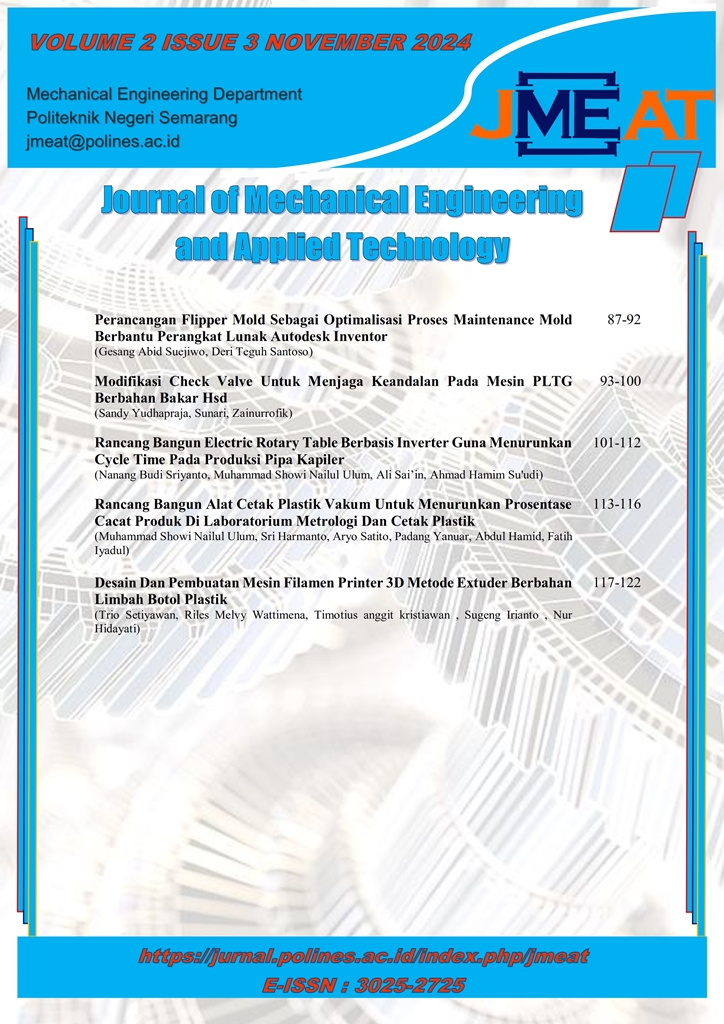RANCANG BANGUN FLIPPER MOLD SEBAGAI OPTIMALISASI PROSES MAINTENANCE MOLD BERBANTU PERANGKAT LUNAK AUTODESK INVENTOR
DOI:
https://doi.org/10.32497/jmeat.v2i3.5916Keywords:
Autodesk Inventor, Flipper Mold, Inovasi, Maintenance, ManufakturAbstract
Proses maintenance mold sangat penting dalam industri manufaktur untuk menjamin kelancaran produksi dan kualitas produk. Penelitian ini bertujuan untuk mengoptimalkan proses perawatan mold dengan merancang alat bantu inovatif, yaitu flipper mold, menggunakan perangkat lunak Autodesk Inventor Professional 2024. Metode yang digunakan meliputi desain parametrik model 2D dan 3D, pemilihan material baja medium carbon steel, serta simulasi mekanis untuk memastikan ketahanan alat. Hasilnya, flipper mold mampu meningkatkan efisiensi perawatan mold, mengurangi kebutuhan operator dari dua menjadi satu, serta mempermudah pembalikan mold yang beratnya mencapai 200kg. Desain ini berhasil mengatasi kendala akses pada bagian mold yang sulit dijangkau dan meningkatkan efisiensi operasional.References
A. K. Mufid, C. Budiyantoro, and M. B. N. Rahman, “Perancangan Injection Molding Dengan Sistem Three Plate Mold Pada Produk Glove Box,” JMPM: Jurnal Material dan Proses Manufaktur, vol. 1, no. 2, pp. 72”“81, 2017.
A. H. P. Ningtyas, K. Ayunaning, B. A. Prambudiarto, and I. Maulana, “Implemetasi Penggunaan Software AutoDesk Inventor Dalam Meningkatkan Kompetensi Menggambar Teknik pada Pelajar Kejuruan,” Universitas Muhammadiyah Gresik, pp. 161”“169, 2021, doi: 10.33061.
M. Al Hafiz, A. Junaidi, and E. Sundari, “Analisis Kekasaran Molding Berbasis Additive Manufacturing Material Polylactic Acid,” Machinery Jurnal Teknologi Terapan, vol. 3, no. 3, pp. 69”“76, 2022, doi: 10.5281/zenodo.7246701.
N. A. R. Pane and A. Sudiyanto, “Proses Pengecoran Dan Manufaktur Logam,” Journal of Metallurgical Engineering and Processing Technology, vol. 1, no. 2, pp. 123”“130, 2021.
M. F. Alfahran, Sumadi, and D. Yuliaji, “Rancang Bangun Alat Pembalik Cetakan Tahu Menggunakan Motor Kapasitas 5 Kilogram,” Jurnal ALMIKANIKA, vol. 2, no. 1, pp. 8”“14, 2020.
C. C. Lin, T. C. Wu, Y. S. Chen, and B. Y. Yang, “A Semi Analytical Method for Designing a Runner System of a Multi Cavity Mold for Injection Molding,” Polymers (Basel), vol. 14, no. 24, p. 5442, 2022, doi: 10.3390/polym14245442.
N. Diswiratna, I. Nugraha, and A. Santosa, “Analisa dan Perancangan Mold Untuk Membuat Mangkuk Plastik Menggunakan Inventor,” TEDC, vol. 16, no. 3, pp. 215”“219, 2022.
A. I. Yunus et al., Mekanika Teknik II. Padang: PT Global Eksekutif Teknologi, 2023.
L. A. N. Wibawa, Merangcang Komponen Roket 3D Dengan Autodesk Inventor Professional 2017, 1st ed. Solo: bukuKatta, 2018.
B. P. Kamiel, G. A. Nugraha, and S. Sunardi, “Perancangan dan Analisis Kekuatan Frame Sepeda Lipat Menggunakan Autodesk Inventor,” JMPM: Jurnal Material dan Proses Manufaktur, vol. 2, no. 2, pp. 126”“135, 2018, doi: 10.18196/jmpm.2229.
H. Yanto, J. Waluyo, and N. Lestari, “Perancangan Bangku Pendek (Dingklik) Berbahan Plastik Dengan Bantuan Simulasi CAD/CAE,” SIMETRIS , vol. 15, no. 2, pp. 22”“28, 2021.
R. Ramdani, A. Saleh, and K. Julkifli, “Rancang Bangun Mesin Penggiling Biji Jagung,” Jurnal TEDC, vol. 17, no. 3, pp. 207”“211, 2023.
T. W. Ridono, A. Gamayel, and M. Zaenudin, “Simulasi dan Analisis Desain Mold Dengan Software Autodesk Fusion 360 Untuk Produk Aksesoris,” Techno (Jurnal Fakultas Teknik, Universitas Muhammadiyah Purwokerto), vol. 25, no. 1, p. 11, May 2024, doi: 10.30595/techno.v25i1.19489.
M. S. D. Ellianto and P. L. Wahyudi, “Perancangan Mold Base Dengan Sistem Two Plate Mold Untuk Produk Spesimen Uji Tarik,” Motor Bakar: Jurnal Teknik Mesin, vol. 7, no. 1, pp. 7”“14, 2023.
A. Fahmi, T. Rusianto, and H. Saputra, “Perancangan Helm Proyek Dengan Metode Injection Molding Plastik Menggunakan CAD,” PROSIDING SNAST, pp. C25-34, Nov. 2022, doi: 10.34151/prosidingsnast.v8i1.4131.
B. H. Irawan, P. Septaningrum, I. Wijayanti, R. Hakim, and I. Saputra, “Perancangan Dan Modifikasi Mold Insert Untuk Meningkatkan Kapasitas Produksi Light Guide,” Jurnal Rekayasa Mesin, vol. 14, no. 3, pp. 927”“938, Dec. 2023, doi: 10.21776/jrm.v14i3.1457.
Downloads
Published
Issue
Section
License
Authors who publish articles in this journal agree to the following terms:
The author owns the copyright and grants first publication rights to the Journal with work simultaneously licensed under a Creative Commons Attribution License which allows others to share the work with the work acknowledged and first published in this journal
Authors may enter into separate, additional contractual agreements for the non-exclusive distribution of the journal's published version of the work (for example, posting it to an institutional repository or publishing it in a book), with an acknowledgment of the first publication in this journal.
Authors are permitted and encouraged to upload their work online (for example, in an institutional repository or on an author's website) before and during the submission process, as this can lead to productive exchanges, as well as earlier citations and a larger number of citations of the published work. (See the impact of open Access).






